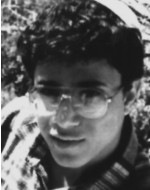Ben Sa’ada and Shlomo. He was born on August 22, 1965 in Rosh Ha’ayin, the youngest son of a family of seven. He attended elementary school in his hometown and in 1977, with the establishment of the Kfar Ganim high school, he joined the founders of the first class. In 1983 he completed his high school studies with honors, and in 1983, as a natural continuation of his education at the Yeshiva, where he went to the “Karnei Shomron” hesder yeshiva, where he grew up in Ma’alot HaTorah. Rachamim wrote an important and comprehensive work on the subject of “Shmirat Halashon” which he presented to Rabbi Yitzhak Halevy, one of the rabbis of the yeshiva, and received great praise from him. Quiet, modesty and humility characterized him. Mercy labors in the tent of Torah. He was an artist in listening and always strived for clarity, precision, exhaustion and definition. With a quick and profound perception and analytic thought. His speech is concise. Every matter he learned he liked to analyze for the finest crumbs to be satisfied. He had a developed sense of order and aesthetics, and order also dominated his inner world, everything in its place and weight. Rahamim was very fond of walking through the magical paths of our country and showed great affection for the land and gardening work, which he often engaged in. He expressed his strong love for Israel. At the end of April 1984, Rahamim enlisted in the IDF as part of the Karnei Shomron hesder yeshiva and was stationed as a combat soldier in Givati’s Shaked Battalion. As in a yeshiva, so too in the army were his physical and spiritual powers, his endurance and resourcefulness manifested. Rahamim served in the IDF out of a clear sense of right and duty, and out of a feeling of responsibility and purpose, he stood out in the army and yeshiva, during the difficult journeys, the exhausting training and the dangerous operations in Lebanon, always encouraging and encouraging Moral. Calm and eternal, and maintained an expression that never completely revealed what was going on in. It had a combination of agility and courage on the one hand, and on the other hand moderation, composure, and coolness characterized his behavior in all situations on Monday, 8 Adar I 5746 (17.2.1986) At 12:00 noon, three Mercedes cars left for a tour of the security zone in south Lebanon, 18 With soldiers from the SLA, about 500 meters south of the Beit Yahun junction, were ambushed by Hizbullah terrorists who fired heavy gunfire at them, and when they were trapped in their vehicle, Rahamim and his friend Yosef Fink ran a heroic battle and waited until their ammunition was exhausted. Hezbollah terrorists were equipped with vehicles nearby, and on the day after the abduction, Hezbollah showed two men wearing head to toe and announced that they were the kidnapped Israeli soldiers and that after a day they would release their demands. If the demands are met, the soldiers will be released and not one of them will be killed. The next day, on February 19, 1986, the CBS television network from Damascus presented the personal belongings of Rahamim and Yosef. For some five years or so, indirect information came in and contradicted their situation. It was sometimes claimed that one of them was alive and sometimes that both of them were alive. On September 19, 1991, after years of official and unofficial negotiations, some 150 terrorists were released and a special envoy of the United Nations was able to convey the message that Rahamim and Yosef were not alive, and that five more years passed before the Hizballah, with the intervention of the German government , Agreed to return the bodies of Rahamim and Yosef, in return for the return of the bodies of 128 terrorists.Two July, 1996, Rahamim was brought to the grave of Israel. He was buried on Mount Herzl in Jerusalem. Survived by his parents and six brothers and sisters – Mordechai, Menashe, Ephraim, Esther, Yael and Yocheved. His family commemorated the donation of a Torah scroll to the synagogue in Rosh Ha’ayin.
